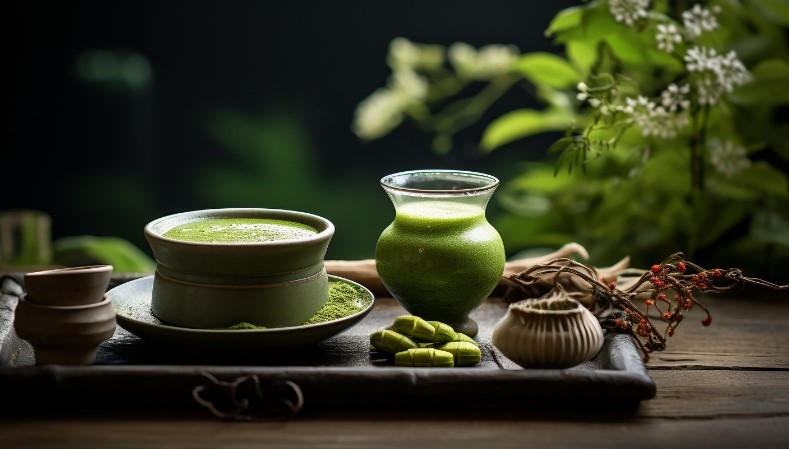말차의 방법

의 관계 말차 스위스와 시계, 프랑스와 향수처럼 '긴밀'하지는 않지만 항상 밀접하게 연결되어 있습니다.
오늘날 일본 말차는 오랫동안 일본 차 마시는 문화의 가장 중요한 상징이자 매개체가 되었으며 점점 더 많은 소비자들에게 사랑받고 인정받고 있습니다.
전달
대중적인 용어로, 말차 는 찻잎을 특수 가공한 후 가루로 만든 차 제품입니다. 초기에 말차가 한자로 '마지막 차'로 표기된 이유도 여기에 있으며, 여기서 '마지막'은 '가루', '부서진 가루'를 뜻합니다.
일본에서 차를 마시는 사람들이 늘어나는 데 어려움이 없었던 것은 아닙니다.
일본의 역사 기록에 따르면, 나라 시대 초기에 일본 승려 유키가 중국 차나무를 일본으로 가져왔다고 합니다. 하지만 당시에는 차 재배가 대중화되지 않았습니다.
나라와 헤이안 시대에 일본의 차 문화는 아직 고유 한 특성을 개발하지 못했지만 중국 차 문화를 예비 연구하고 모방 한 것에 불과했습니다. 리위팅 왕조의 귀족, 승려 및 상류층 사이에서 차 심기, 차 만들기, 차 마시기, 각 단계는 당나라와 비슷하며 모방의 맛이 매우 강합니다.
가마쿠라 시대에 일본의 차 문화는 지역의 종교, 철학, 미학 등과 통합되기 시작하여 '차 수프'라는 일본 스타일을 형성했습니다. 말차의 응용 또한 일본 차 문화의 중요한 부분이 되었습니다.
흥미롭게도 무로마치 시대에 이르러 일본의 차 마시는 스타일이 바뀌기 시작했습니다. 이때 중국은 명나라에 들어갔지만 바다 건너 일본은 갑자기 중국 송나라의 차 예술을 동경하고 송나라의 '싸움 차'의 바람을 모방하여 자체 '싸움 차'예술을 형성했습니다.
무로마치 시대 초기에는 호화로운 '차 싸움'이 주류가 되었습니다. 송나라의 우아한 "차 싸움"과 달리 일본 사무라이 계급의 "차 싸움"의 목적은 사회적 접촉을 확대하고 부를 과시하며 물론 먹고 마시는 것이 었습니다. 그러한 "싸움 차"가 실제로 우아하지 않기 때문에 고급 "싸움 차"가 번성하고 쇠퇴하고 동산 아카데미의 차 문화가 부상하기 시작했기 때문일 수 있습니다.
무로마치 시대 중기의 매우 대중적인 문화인 히가시야마 문화는 책과 관련된 분위기가 강합니다. 당시 무라타 선사의 지도 아래 아카데미 차는 외국의 중국 문화와 일본 문화를 결합하여 "차 수프"를 더욱 기술적으로 만들었고 일본 다도도 형성되었습니다. 이 때문에 히가시야마 시대, 즉 히가시야마 문화는 일본 다도의 역사에서 매우 중요한 위치를 차지하고 있습니다.
나라 시대와 헤이안 시대, 가마쿠라 시대와 무로마치 시대, 에도 시대와 현대를 거쳐 일본의 차 문화는 마침내 성숙해졌습니다.
접근 도로
차 문화의 현지화 과정에서 거장들이 속속 등장하면서 섬세하고 절묘하며 멋진 것이 일본 다도의 특징이 되었습니다.
품질 향상
무로마치 시대에 우지 차 농부들은 현지 토양과 기후에 맞는 '멀치 재배법'을 발명했는데, 차를 따기 전에 차나무를 '덮어' 말차를 더 푸르고 달콤하게 만드는 것으로, 우지 말차도 유명합니다.
프로세스 개선
당시 일본인에게 차는 음료라기보다는 공예품에 가까웠습니다. 차 제조 과정에서도 이를 반영하여 더 엄격한 단계와 더 정교한 작업이 이루어집니다. 따기 전 차광, 따기 후 증기로 죽이기, 오븐에서 굽기, 절단 및 분쇄에 이르기까지 12 개 이상의 공정이 절묘하며 미세 분쇄 가공 링크에 사용되는 석재 분쇄기조차도 자연을 추구합니다.
차 스타일 리폼
동산 아카데미의 차 문화에서 예술가 넝아미는 중요한 대표자입니다. 그는 전사로 태어났으며 글과 그림, 차에 정통합니다. 그의 후원 아래 일본 다회는 화려하고 시끄러운 바람을 휩쓸고 '아카데미 장식'과 '테이블 장식'이라는 새로운 차 스타일을 형성하기 시작했습니다.
다도 만들기
노이의 추천으로 무라타는 말년에 아시카가 요시마사 장군의 다도 선생이 되었습니다. 동산 아카데미의 차 문화를 충분히 이해하고 장군이 수집한 수많은 문화 예술 보물을 접한 후 무라타 펄의 다도 사상은 한 단계 더 도약하게 됩니다. 그는 서민층의 나라 류 '소안차'와 귀족층의 '아카데미 차'를 결합하여 차 문화에서 다도로의 중요한 단계를 완성했습니다. 무라타 진주는 "일본 다도의 조상"으로도 알려져 있습니다.
이 시점에서 다도의 형성에 필요한 세 단계, 즉 민속 차, 차와 선의 결합, 귀족 차와 민속 차의 통합이 모두 완성되었습니다. 수년간 중국의 차를 마시는 관습을 받아들인 일본인들은 마침내 그들만의 다도를 발전시켰습니다.
말차 공급업체: www.backvita.com
이메일: [email protected]
전화 +86 (029) 8187 2325
